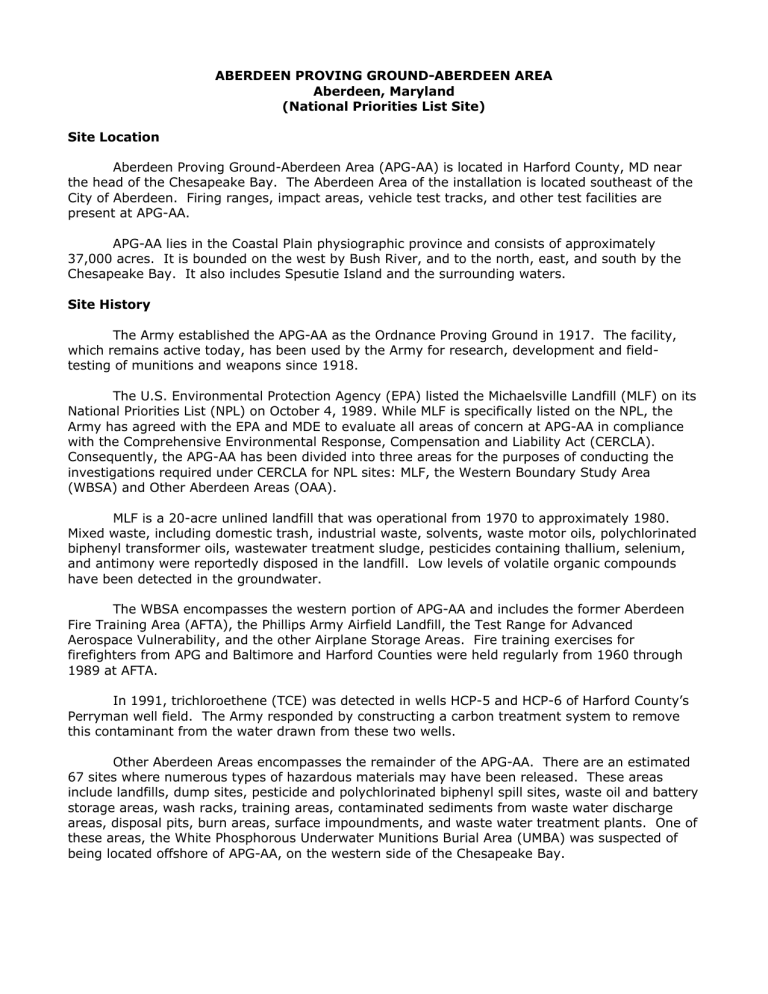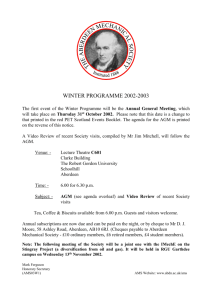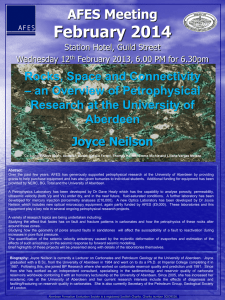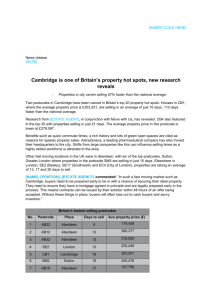Aberdeen Proving Ground-Aberdeen Area

ABERDEEN PROVING GROUND-ABERDEEN AREA
Aberdeen, Maryland
(National Priorities List Site)
Site Location
Aberdeen Proving Ground-Aberdeen Area (APG-AA) is located in Harford County, MD near the head of the Chesapeake Bay. The Aberdeen Area of the installation is located southeast of the
City of Aberdeen. Firing ranges, impact areas, vehicle test tracks, and other test facilities are present at APG-AA.
APG-AA lies in the Coastal Plain physiographic province and consists of approximately
37,000 acres. It is bounded on the west by Bush River, and to the north, east, and south by the
Chesapeake Bay. It also includes Spesutie Island and the surrounding waters.
Site History
The Army established the APG-AA as the Ordnance Proving Ground in 1917. The facility, which remains active today, has been used by the Army for research, development and fieldtesting of munitions and weapons since 1918.
The U.S. Environmental Protection Agency (EPA) listed the Michaelsville Landfill (MLF) on its
National Priorities List (NPL) on October 4, 1989. While MLF is specifically listed on the NPL, the
Army has agreed with the EPA and MDE to evaluate all areas of concern at APG-AA in compliance with the Comprehensive Environmental Response, Compensation and Liability Act (CERCLA).
Consequently, the APG-AA has been divided into three areas for the purposes of conducting the investigations required under CERCLA for NPL sites: MLF, the Western Boundary Study Area
(WBSA) and Other Aberdeen Areas (OAA).
MLF is a 20-acre unlined landfill that was operational from 1970 to approximately 1980.
Mixed waste, including domestic trash, industrial waste, solvents, waste motor oils, polychlorinated biphenyl transformer oils, wastewater treatment sludge, pesticides containing thallium, selenium, and antimony were reportedly disposed in the landfill. Low levels of volatile organic compounds have been detected in the groundwater.
The WBSA encompasses the western portion of APG-AA and includes the former Aberdeen
Fire Training Area (AFTA), the Phillips Army Airfield Landfill, the Test Range for Advanced
Aerospace Vulnerability, and the other Airplane Storage Areas. Fire training exercises for firefighters from APG and Baltimore and Harford Counties were held regularly from 1960 through
1989 at AFTA.
In 1991, trichloroethene (TCE) was detected in wells HCP-5 and HCP-6 of Harford County’s
Perryman well field. The Army responded by constructing a carbon treatment system to remove this contaminant from the water drawn from these two wells.
Other Aberdeen Areas encompasses the remainder of the APG-AA. There are an estimated
67 sites where numerous types of hazardous materials may have been released. These areas include landfills, dump sites, pesticide and polychlorinated biphenyl spill sites, waste oil and battery storage areas, wash racks, training areas, contaminated sediments from waste water discharge areas, disposal pits, burn areas, surface impoundments, and waste water treatment plants. One of these areas, the White Phosphorous Underwater Munitions Burial Area (UMBA) was suspected of being located offshore of APG-AA, on the western side of the Chesapeake Bay.
Environmental Investigations
In order to manage the investigation and cleanup at this site, the Army designated two operable units (OU) for MLF. OU-1 is the landfill source area and OU-2 is the remaining media at the site, i.e., the groundwater, soil, surface water and sediment. The remedial investigation (RI) for OU-1 MLF was completed in January 1992, and the Record Of Decision (ROD) for OU-1, which designated a landfill cap as the remedy, was signed by June of that year. The cap was completed in 1994, and the ROD for OU-2 subsequently signed in September of 1997. The OU-2 ROD specified no further action with long-term monitoring. In addition, it recognized the existing groundwater use restrictions within 0.25 mile of MLF.
The WBSA was originally divided into three OUs. OU-1 encompasses the southwestern portion of WBSA and includes all of the groundwater, which flows to the south, southwest and towards the well field at Perryman. OU-2 includes the groundwater, which flows northward toward the well field at the city of Aberdeen. OU-3 originally included all other media within the entire
WBSA, such as the soil, sediment and surface water. The RI for OU-1 was completed in 1999, the
ROD was signed in July 2000, and a 95% design submittal for construction of an expanded and relocated Carbon Treatment System for all eight Perryman wells was submitted in July 2001. The
RI for OU-2 is ongoing. A designated OU-4 was established in 2003 based on a reorganization of ecological risk issues and site priorities.
A ROD was signed in 1991 for the White Phosphorous UMBA that specified long-term monitoring. In 1997, a five-year review of the White Phosphorous UMBA ROD was completed. The
EPA and MDE agreed that no further evaluation of the site was warranted. The RI for the remainder of OAA is ongoing. A draft RI screening report for 36 sites in OAA was completed in
October 2000. A follow-up work plan for additional RI work was submitted in October 2001.
Significant contamination was identified at five of the OAA sites; therefore, the Army has separated these sites from the main body of work, in effect, placing more emphasis on their particular remediation issues. In addition, 11 removal actions have been completed at APG-AA since 1990.
Current Status
As discussed above, the Army is continuing to conduct RI work at the WBSA and the OAA of
APG-AA. A design plan by the Army to construct a carbon treatment unit at the Perryman water treatment plant was awarded in May 2002. Plant construction began in June and was completed in
September of 2003. The Army has completed a removal action to include 3700 feet of shoreline stabilization for the Abbey Point ordnance disposal area on the western portion of the Aberdeen peninsula. In July of 2002 perchlorate was detected in drinking water wells at the City of Aberdeen
Well field, OU2 of WBSA. The finished water is being monitored on a weekly basis, while individual wells are monitored one to two times per month. Local potential contamination source areas are being evaluated, and the Army is in communication with the MDE and with EPA to address community concern over any potential health risks.
Future Activity
The Army and EPA are discussing delisting MLF from the NPL.
Facility Contacts
John Fairbank Maryland Department of the Environment (410) 631-3440
Federal/NPL Superfund Division
Frank Vavra U.S. Environmental Protection Agency (215) 814-3221
Naren Desai Directorate of Safety, Health and Environment (410) 436-4569
Aberdeen Proving Ground









